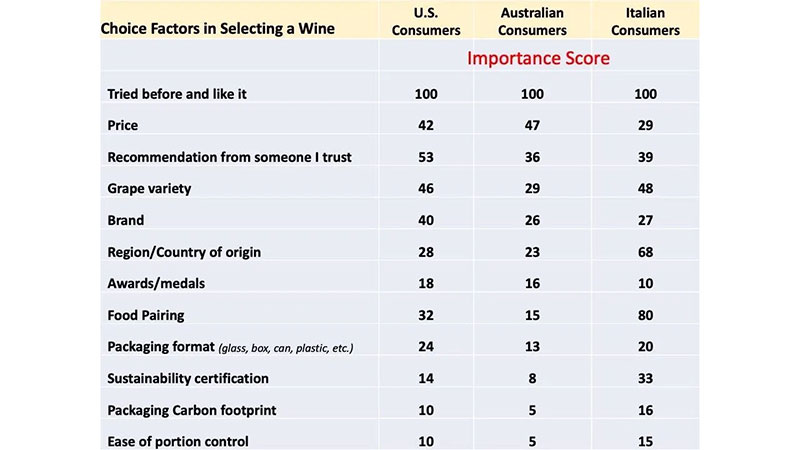A new survey conducted in May of this year revealed major differences between how consumers in different countries approach buying wine. The study was a collaboration between researchers from the University of Adelaide, the University of Florence, Sonoma State University, and University of South Australia, with funding support from Ron Rubin Winery.
The survey included a total sample size of 2,014 wine consumers across each country, focusing on 12 typical wine purchasing decision factors. All three countries agreed that the most valuable factor in selecting a wine is having tried it before and liked it, showing that taste and familiarity are key in making a decision for all consumers. However, there were some glaring differences between the U.S. and Italy in some of the other categories. Here are six major differences between how Americans and Italians buy wine.
Opinions of Others
When asked about the role of a recommendation from someone they trust in selecting a wine, U.S. consumers gave this category an importance score of 53 out of 100, whereas Italians consumers rated it a 39. Perhaps this is a reflection of Italy’s prominent wine culture, showing that Italian consumers have more confidence in their knowledge to choose a wine on their own, and U.S. drinkers depend more on recommendations. Similarly, U.S. consumers valued awards and medals higher in their decision making than Italians, showing again that they are more likely to factor in expert advice.
Region/Country of Origin
The importance score of region or country of origin for Italian consumers was 68, whereas U.S. consumers ranked it at 28. While we can’t know this for sure, maybe Italian consumers have a strong preference for their own nation’s wines, and aim to support specific regions with more intention. While the U.S. also has incredible winemaking regions, its wine shops and restaurants are definitely more globally focused, so American consumers might be more open to drinking bottles from around the world.
Brand
In line with typical American consumerism, U.S. wine drinkers value the name brand of a wine pretty highly with a score of 40. Italian consumers only ranked this category with an importance score of 27. According to the survey, it’s apparent that while Italians look for the region or country of origin, U.S. buyers are looking for a recognizable name or label.
Price
U.S. drinkers also factor in price more than their Italian counterparts, giving it an importance score of 42 against the latter’s 29. You can easily find great regional options for low prices in Italy, so price might not be as much of a factor for its residents. However, this category doesn’t offer added context, so it is unclear whether or not Americans are looking for wines with a higher price point, or looking for more savings when buying a bottle.
Sustainability Certification
While sustainability certification did not rank extremely high for either country, the Italian consumers ranked it a bit higher at 33, compared to a score of 14 for U.S. consumers. This was also reflected in the scores for packaging carbon footprint, which Italy valued more than the U.S.
Food Pairing
Of course, the most glaring difference between these two nations is how the wine pairs with food. Italian drinkers ranked this at 80, compared to the U.S. consumers’ importance score of only 32. Drinking at meals is deeply rooted in Italian culture, so enjoying certain wines with regional cuisines is part of day-to-day life. Wine drinking in the U.S. is much less dependent on food, so what’s on the menu for dinner is not going to impact their wine store decision.



